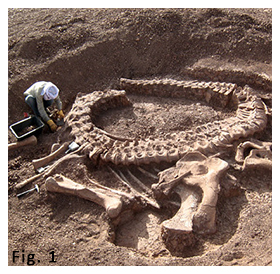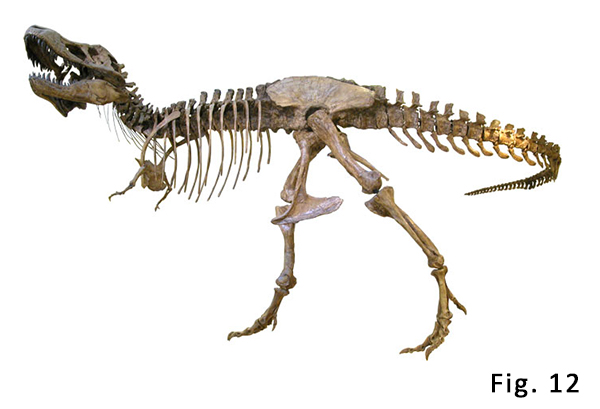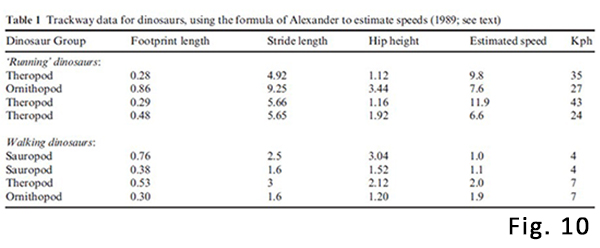-
About

"Well, we clocked the T-Rex at 32 miles an hour."
-John Hammond (Jurassic Park, 1993)
How fast could a T-rex run? How do we know? What can/can't we infer? Did Jurassic Park get it right? These are questions that I intend to answer with this website.
When the term ‘dinosaur’ was first coined in 1841 by Richard Owen, he concluded that this new group of reptiles moved more like birds and mammals rather than modern reptiles by studying the limb anatomy of dinosaurs. The joints kept the feet close to the midline of the body implying an erect posture. This also restricted most limb movements to a plane parallel to the body (parasagittal gait). However, over time depictions of dinosaurs reverted to a more ‘sluggish reptile’ paradigm and this perspective eventually became entrenched in the scientific and public mind for many decades. Dinosaurs had historically been depicted dragging their tails and moving with a more sprawling posture resembling modern reptiles until the study of dinosaur locomotion went through a renaissance in the late 1960s–1970s and a more mammal or bird-like model of dinosaur locomotion gained dominance.[1]

Unlike investigators working exclusively on living animals, palaeobiologists can’t directly record the motion, measure the forces or dissect the soft-tissue anatomy of their study organisms. Rather than consigning this problem to the unknowable, we can make general inferences about individual species, as well as about large-scale patterns of locomotor evolution.[2]
-
Methods

Our goal is to conduct a quantitative assessment of T-rex speed and we can do this best using three methods, comparison with living analogs, muscle/bone scaling, and ichnology.
Comparison with Living Analogs: Close comparison with hoofed mammals, birds, elephants, alligators and rhinoceroses reveal broad similarities.
Read More -
Results

Comparison with Living Analogs: Extensor Muscle Mass (T) is defined as a percentage of body mass as extensor muscles. This is used to determine physical capability of running. A lower T-value indicates greater running ability. In our model, an alligator had a t-value of 3.6% per leg as extensor muscles. An alligator would require a t-value of 7.7% per leg to run quickly on its hindlimbs. A Gallus, otherwise known as a rooster, had a t-value of 8.8% mbody per leg as extensor muscles. A gallus would only require a t-value of 4.7% per leg to run quickly on its hindlimbs. The Tyrannosaurus in our model would require a t-value of 43% per leg as extensor muscles to run quickly which is such a great value that it is considered physically impossible to attain.[3]

Muscle/Bone Scaling: It is generally accepted that as the mass of an animal increases, a greater reduction to mobility follows. Our equation above dictactes that there is an exponential decrease in mobility as mass increases.
Read More -
Conclusions

"Well, we clocked the T-Rex at 32 miles an hour."
-John Hammond (Jurassic Park, 1993)
Through the use of modern analogs, we were able to make anatomy comparisons to determine that larger theropods (e.g. T-Rex) did not have sufficient muscle to propel them at high speeds. Additionally, the exponential growth rate of pubescent Tyrannosaurs indicates that adult Tyrannosaurs would have reached such a large mass that would inherently be detrimental to acheiving high velocities. Evidence from trackways also serves to confirm that theropods did not acheive speeds of 32mph as stated in the film Jurassic Park.

-
References
1] Hutchinson, J. R. (2001). Dinosaur Locomotion eLS: John Wiley & Sons, Ltd.
2] Hutchinson, J. R., & Gatesy, S. M. (2006). Dinosaur locomotion; beyond the bones. Nature (London), 440(7082), 292-294. doi: http://dx.doi.org/10.1038/440292a
3] Hutchinson, J. R., & Garcia, M. (2002). Tyrannosaurus was not a fast runner. Nature (London), 415(6875), 1018-1021.
Fig. 1 - http://www.ammonit.ru/upload/news/738.jpg
Fig. 2 - http://members.aol.com/Dinoplanet/dinosaur.html
Fig. 3 - http://www.nature.com/nature/journal/v415/n6875/fig_tab/4151018a_T1.html#figure-title
Fig. 4 - http://www.nature.com/nature/journal/v415/n6875/fig_tab/4151018a_F3.html#figure-title
Fig. 5 - http://onlinelibrary.wiley.com/doi/10.1038/npg.els.0003320/full
Fig. 6 - http://onlinelibrary.wiley.com/doi/10.1038/npg.els.0003320/full
Fig. 7 - http://features.cgsociety.org/newgallerycrits/g38/384038/384038_1361550242_large.jpg
Fig. 8 - http://www.nature.com/nature/journal/v415/n6875/full/4151018a.html#Methods
Fig. 9 - http://paleo.cc/paluxy/px99-s6-3.jpg
Fig. 10 - http://onlinelibrary.wiley.com/doi/10.1038/npg.els.0003320/full
Fig. 11 - http://www.nature.com/news/2011/111107/images/news631-i1.0.jpg
Fig. 12 - http://www.codehesive.com/wp-content/uploads/2012/02/trex3.jpg
Background Image 1 - http://www.aceshowbiz.com/images/still/tyrannosaur-poster02.jpg
Background Image 2 - http://asociacionconciencia.files.wordpress.com/2013/11/trex-3d.jpg
Background Image 3 - http://www.yoand.biz/wp-content/uploads/2014/03/rex-dinosaur-coloring-page-striped-t-rex-dinosaur-coloring-pages.jpeg -
Read more

Muscle/Bone Scaling: Changes in dinosaur bone with size.

Ichnofossils: Trace fossils reveal direct information on posture, limb orientation, and speed. Footprint length is used to estimate the hip height of an animal (usually as footprint length times four, which is a fairly reasonable number for many dinosaurs). The hip height and stride length, or distance between two successive falls of the same foot, are used in an equation to calculate speed in m/sec. The speed estimation equation was obtained by measuring the speeds, stride lengths and hip heights of many walking and running extant animals.[1]

-
Read more

Ichnofossils Trackways provide us with direct information for estimating velocity. Footprint length is used to estimate the hip height of an animal (usually footprint length times four). We unfortunately do not have a confirmed Tyrannosaur trackway available, however, we have other Theropod trackways which we will use for our model.

Using our model, the fastest Theropod is estimated to have reached speeds of 35kph (~22mph).
More Website Templates @ TemplateMonster.com -September 19th, 2011!